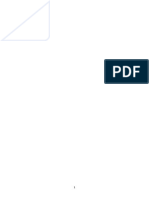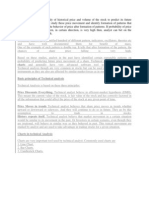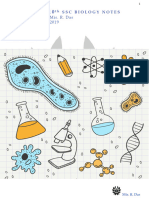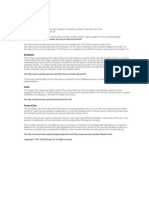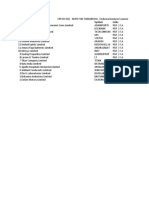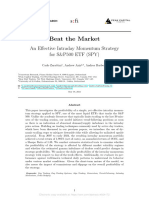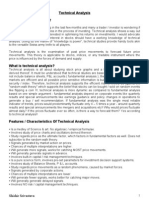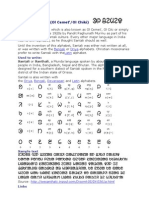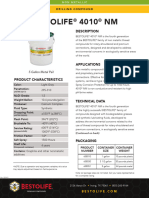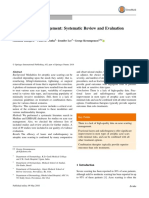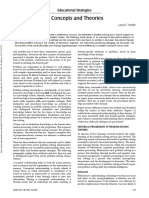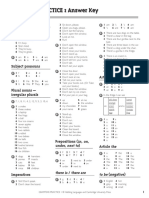Khalitya (Hair Fall) Management - Ayurvedic: Perspective
Khalitya (Hair Fall) Management - Ayurvedic: Perspective
Uploaded by
mehak cCopyright:
Available Formats
Khalitya (Hair Fall) Management - Ayurvedic: Perspective
Khalitya (Hair Fall) Management - Ayurvedic: Perspective
Uploaded by
mehak cOriginal Title
Copyright
Available Formats
Share this document
Did you find this document useful?
Is this content inappropriate?
Copyright:
Available Formats
Khalitya (Hair Fall) Management - Ayurvedic: Perspective
Khalitya (Hair Fall) Management - Ayurvedic: Perspective
Uploaded by
mehak cCopyright:
Available Formats
International Journal of Health Sciences and Research
www.ijhsr.org ISSN: 2249-9571
Review Article
Khalitya (Hair Fall) Management - Ayurvedic
Perspective
Dr. Princy Purwar1, Dr. S. S. Yadav2, Dr. Pragya Gangele3
1
JR 2, 2Assistant Professor, 3JR 3,
Department of Samhita & Sanskrit, Faculty of Ayurveda, IMS, BHU, Varanasi,
Corresponding Author: Dr. Princy Purwar
ABSTRACT
Ayurveda is a deep ocean of knowledge in which not only systemic disease but also local minor
diseases are described in detail. Hair fall is one of the minor diseases which is affecting approximately
1.7% of the world population and challenging task for physicians. Hair fall has been described in
Ayurveda by the name of khalitya roga under the heading of kshudra roga (minor disease) or
shiroroga (diseases of head & scalp). It is progressing disorder people living in sedentary ways of life,
stress induced hectic schedules along with indiscriminate dietary habits result in many disturbance
and deficiencies in the body which directly reflect in loss of hair. We can reduce & manage this rising
problem of hair fall through modifying life style, purification therapy and medication practicing in
Ayurveda.
Key words: Khalitya, indralopa, hair oil, nasya.
INTRODUCTION esteem and heightened self-consciousness in
Healthy, long and vibrant hair helps people affected by hair loss. [1]
a lot in improvement of personality. Hair fall has been described in
Therefore, to keep hair in healthy state is almost all the Ayurvedic literatures as
entirely duty of human being, because just Khalitya. It has been included in Shiroroga
like face, hair is also a mirror of healthy by Acharya Charaka & Ashtanga
state of body. In this advanced modernized hridayakar. This inclusion has been done on
era, the humans are gifted with lot of the basis of Shtana (location) of diseases
sophistication, luxuries but at the same time and similarity of etiopathogenesis of
left with sedentary life style, stress induced diseases. It is clearly mentioned in
hectic schedules along with faulty dietary Ashtanghridaya that nine diseases occurring
habits. These all habits influences the on the outer part of head over scalp should
homeostasis of the body and with many be called shiroroga.
other health problems, fall is one of them. Sushrut Samhita, Ashtangsamgrah,
Problem of falling of hair is progressively Yoga Ratnakar and Madhav Nidan, has
increasing in society which is also affecting included Khalitya diseases under kshudra
quality of life. Many years of hair loss have roga. This inclusion in kshudra roga is due
impact on mental health. Dermatology life to mildness of disease. These diseases are
quality index scores in patients with hair not life threatening and are of less severity
loss were similar to those recorded in severe in comparison to other major diseases.
psoriasis. This study specifically identify the Gayadasa says that they are minor because
feeling of self - confidence, low self - of littleness of their cause, symptoms and
International Journal of Health Sciences & Research (www.ijhsr.org) 255
Vol.9; Issue: 4; April 2019
Princy Purwar et.al. Khalitya (Hair Fall) Management – Ayurvedic Perspective
treatment. They are not only minor but also During this process of production of dhatus
mean terrible which, though of a low stature when metabolism of asthi dhatu occur by its
frequently give pricks and embarrassment to own agni & majja dhatu emerges from sara
patient. part and at the same time hair of scalp &
body and nails form as mala. [2] According
MATERIAL AND METHODS to acharya Sharngadhar, Scalp and body
Literature of all the Ayurvedic texts hair are the updhatu of Majja dhatu. [3]
(both brihat-trayi and laghu- trayi), modern Among the all the garbhaj bhava
medicine literature and new researches (factors for development of foetus), hair is
published are studied for this review work. pitraj bhava means structure, colour and
Khalitya and Indralupta: Gradual falling of quantity of progeny are dependent on
hair is known as Khalitya. When pitta paternal side. [4] Hair made up of mainly
combines with vata or kapha dosha to parthiva mahabhoota (earth element). Hair
destroy the hair, it is called khalitya. [7] formation starts during sixth month of
According to Acharya Chraka, The tejas intrauterine life. [5]
dhatu (heat of body) of the body in According to modern science, Hair
association with vayu and other dosha, can be defined as modified epithelial
scorches up the hair-root (scalp) giving structure formed as a result of keratinisation
instantaneous rise to alopecia (khalitya) in of germination cell. Hair is an epidermal
man. One more term used in texts for hair appendage that lies with the dermis. Every
fall is Indralupta. Ruchya and chach are two hair emerges from the hair follicles which
of its synonyms. [8] According to Acharya resembles like a slim pocket insides
kartika, falling of hair from all over the epidermis. Hair is present in every
body is called ruhya. discipline of the epidermis beside the palm,
There are some differences between sole and lips. Hair development undergoes a
khalitya & Indralupta. In khalitya, hair loss repetitive cycle. In the scalp, hair growth
is gradual and generalised over the scalp but cycle has three essential phases: Anagen,
hairs are lost suddenly and patch by patch in Categen and Telogen. The anagen segment
indralupta. When the kapha dosha is a progress phase which most commonly
combines with rakta dhatu it results in lasts 3-5 years. One a healthy scalp, there
degeneration and shutting down completely are roughly 100000 hair & 90% of the
of hair follicles thus leading to baldness. follicles are consistently in the anagen
When Khalitya is due to vata it causes segment of hair development. Categen stage
burning over scalp; when due to pitta it follows this phases, when the follicles
causes sweating and when due to kapha it begins to end up dormant which lasts for 2-3
causes thickening of skin. [8] week. The telogen stage is a dormant stage
or resting interval that lasts 3-4 months.
Origin of hair- When this stage ends, hair falls out. That
Ayurveda mentioned that human body is hair follicle then returns to the anagen stage
made up of main seven dhatus (body & a new hair begins to develop. In this way,
elements) viz. Rasa, Rakta, Mansa, Meda, hair growth cycle continues. 50-60 hairs are
Asthi, Majja and sukra. Majority of lost per day in normal hair growth cycle. [6]
acharyas belief that the production of later
dhatu occurs from former dhatu by the Causes of Khalitya Roga-
function of their respective agni i.e. the Due to usna guna of pitta dosha
rasagni turns the ahara rasa into rasa dhatu individual of pitta prakriti starts hair fall
then raktagni converts part of rasa dhatu in and greying of hair earlier than
rakta and so on. Along with production of individuals of other dosha prakriti. [9]
later dhatu, there is side by side production The hair has tendency to lose its natural
of upadhatu & mala of former dhatu. colour with advancing age. Although,
International Journal of Health Sciences & Research (www.ijhsr.org) 256
Vol.9; Issue: 4; April 2019
Princy Purwar et.al. Khalitya (Hair Fall) Management – Ayurvedic Perspective
Aging is genetically predetermined but Hair fall can be caused by decrease in
lifestyle, dietary habits, mental status, asthi dhatu or vitiation of asthi dhatu.
social & family life and many other As hairs are formed by waste product of
environmental factors may influence the asthi dhatu and hair dependent upon it
aging process and their unfavourable for nutrition. [16]
effects cause premature aging. In a Excessive combing during ritukal leads
survey study, 81.66% patients of pre- to hair fall in child. [17] (Su.)
mature aging of 30-40 years age had Causes according to modern science -
complaint of hair fall. Pre-mature aging Nutritional disorder, Local skin disorder,
could be a cause of increasing hair fall Endocrinal diseases, Post - acute illness,
in peoples. [10] Stress, Drugs, Cosmetics and Genetic
Causative factor of shiroroga are too tendencies.
much exposure to smoke, sunlight, mist,
indulge in water sports; excessive sleep Approach to Patient of Khalitya -
or avoiding sleep, sweating, eastern Hair fall can be manifested as
breeze or direct breeze, control of tars, primary disease (as independent disease) as
weeping too much, drinking water & well as secondary to other disorder or can be
wine in large quantity, presence of present as symptom of many diseases.
warms in side body, suppression of Because of its variable etio-pathogenesis,
urges, avoiding the use of pillow, bath we need a careful approach to the patients
and oil anointing, always looking for proper diagnosis and treatment of hair
downwards, unaccustomed, unhealthy, fall (khalitya). Proper history should be
vitiated or raw smell, too much speaking taken including all the criteria like past
etc; by indulgence in these and similar medical history, family history and personal
causes the dosha get aggravated and history along with other general & systemic
produces diseases in head. This can examinations. Scalp & body should be
produce khalitya because of same place carefully examined to detect any
of manifestation. [11] abnormality in skin.
Darunaka (Dendruf) - Deranged kapha
and vayu cause minute fissures on the Management of Khalitya –
scalp which are dry and show sign of 1. Nidanparivarjan - Nidanparivarjan
itching and leads to hair fall. Many should be first line of management. All
times along with kapha and vata, pitta the causative factors & risk factors
gets deranged leading to darunaka. [12] should examine carefully and must be
Daruna mean hard. Although vitiation avoided to reduce development of
of kapha and vata has been mentioned disease.
in darunaka, association (anubandha) of Prevention is better than cure. Individual
pitta and rakta is also seen. [13] of pitta prakriti are more prone to
Excessive consumption of salt and falling of hair. They should follow diet
kshara leads to khalitya. [14] Improper & habit as mentioned for them in
diet or excess salt in diet consumption Ayurvedic texts. Due to accumulation of
by pregnant lady causes khalitya early in pitta dosha in rainy season and vitiation
her child due vitiation of pitta dosha. [15] in autumn season, these months of year
Getting angry, talking & laughing too are more uncertain for patients of hair
much, sneezing and over exertion after fall, individual of pitta prakriti or
taking nasya leads to khalitya and persons with genetic history of baldness.
palitya. Here, hair fall occurs because of These people are strictly advice to
not following agenda after Nasya follow proper routine mentioned for
procedure. rainy and autumn season respectively.
International Journal of Health Sciences & Research (www.ijhsr.org) 257
Vol.9; Issue: 4; April 2019
Princy Purwar et.al. Khalitya (Hair Fall) Management – Ayurvedic Perspective
In hair fall due to premature aging, should be mild and free form chemicals.
Rasayana therapy is needed mainly with Decoction or Shampoo made up of herbs
vayasthapana drugs. like Henna, Bringraj, Jatamansi, Shoe
Patient should protect himself from all flower, Triphala, Ghrit Kumari,
the causes mentioned for shiroroga as Shikakai, Motha, Bhrami etc. can be
hair fall numerated under shiroroga used for washing hair.
according to some author. He should Dhoomapana (medicated smoke)–
protect himself from dust, smoke, fog, Along with health of head & senses,
cold water, sunlight etc. he should avoid dhoomapana cures the problem of hair
sleeping in day time and awakening late fall by clearing the dosha from head
night. region and also improves the firmness of
Patients of hair fall must avoid excessive hair on the head, beard & teeth. [21]
use of salt and kshara in his diet. Kshaurakarma – Hair cutting & proper
Harsh Chemical, heating treatment used care of hair of scalp & beard should be
in practice for cosmetic purpose should done regularly. Acharya charaka
be avoided or minimally used. mentioned that everybody should have a
hair - cut, shave and nail cut thrice every
2. Hair Care- Along with these fortnight. [22]
precautions, patients of hair fall need to Ushnishka – The wearing of ushnishka
adopt a healthy life style for care of hair, (turban or cap) on head protect the hair
discussed in Samhita for the health of from wind, heat, dust etc. which is pious
hair are as following. and beneficial for hair. [23] Covering of
Moordha tail (oiling) and paste for head protect are hairs from
local application over scalp – Oil environmental factor.
should be regularly applied on scalp. It
prevents falling of hair, baldness and 3. Purification Procedure
also makes the hair black long and deep (Panchkarma)- For the patient of hair
- rooted. It provides nourishment to the fall Vaman, Virechan, Vasti and Rakta
hair follicles and also gives strength to mokshana should be done according to
the cortex and fibre of hair. [18] Mustard the dosha involve. Because of
oil or Coconut oil can be used on regular involvement of mainly pitta dosha,
basis for the massage oil hair. virechana and rakta mokshan are
Nasya (nasal drop) – Everybody should commonly indicated in falling of hair &
take nasal drop of “Anu tail” every year baldness.
during the rainy, autumn and spring 4. Medicated Oils for shiroabhyanga are
season when the sky is free from cloud. -
Along with many other benefits, it Neeli tail (Sushrut)
prevents hair fall and also accelerates Sairiyaka tail (Sushrut)
the growth of hair. [19] Nasya nourishes Mahaneel tail (A.H.)
the srotas present above the clavicle Snuhyadi tail (Chakradutta)
including the hair follicles which Chandanadhya tail (Chakradutta)
strengthen the hair and reduce falling. Mulethi + amlalaka + milk + tail paka
Snana (taking bath) – Acharya Sushrut (Chakradutta)
mention that the head and hair should
not be washed with warm water or with 5. Pastes for local application over scalp
very cold water. Pouring warm water are -
over head reduces the strength of hair & Madhuka, amalaka + honey (A.S)
eyes. [20] Proper hair wash should be Tila, amalaka + honey + oil(A.S)
done at least three times in a weak.
Shampoos and soaps used for hair wash
International Journal of Health Sciences & Research (www.ijhsr.org) 258
Vol.9; Issue: 4; April 2019
Princy Purwar et.al. Khalitya (Hair Fall) Management – Ayurvedic Perspective
Kapikakshu mool + aksha tail in iron Shodhana and nasya karma is a specialised
vessel (A.S) therapy of Ayurveda. Shodhana is a
Dugdhika karveera+ milk (A.S) procedure which takes out the doshas from
Kapalaranjaka lepa (Chakradutta) the nearest route of its vitiation. Rasayana
Bhringpushadi lepa (Chakradutta) therapy has immune-modulators,
Mandoor bhasma + amlaki churna + antioxidant properties and rejuvenating
japapushpa then wash with triphala action which is very beneficial for the hair
kwath fall caused by any chronic illness, pre
Ayas churna + triphala + sour liquid mature aging or nutrition deficiency.
(Chakradutta)
CONCLUSION
6. Medicated Oils for Nasal medication Khalitya is a wicked disease which
are - needs proper management. Some minor
changes of life style and dietary habits can
Anu tail Nasya (A.S.)
prevent hair fall. Proper hair care life oiling,
Brihatyadi navana (A.S.)
washing, protection from external factors
Sahacharadi navana (A.S.) like environment, chemicals, heating etc is
Nimba tail (Chakradutta) important for preventing hair fall and
Bhrigaraja rasa + mulethi + milk + tail keeping them healthy. Before starting
paka (Chakradutta) treatment of hair fall, physician should
identify the cause and first treatment should
7. Other yoga & Rasayana for the be Nidanparivarjana or management of that
patient of hair fall mentioned in cause. Than after other therapies like
Charaka Samhita are- Abhyang, lepana, shodhan, nasya,
Agastya haritaki Rasayana hould be prescribed accordingly.
Kankarishta In this way, we can treat the khalitya roga
Dwipanchmool ghrita or hair fall effectively.
Amalaki rasayana
Navayas lauha REFERENCES
1. D Williamson, M Gonzalez, AY Finlay. The
Mandoora bhasma
effect of hair loss on quality of life. European
Academy of Dermatology and Venereology.
DISCUSSION 2001 15, 137-139
Khalitya is a common but very 2. Agnivesha, Charaka Samhita English
challenging and capricious disease of the translation, vol. IV, Chikitsasthan,
world population and can have a profound grihanidoshachikitsa adhyaya (15; 19).
effect on physical and emotional state. Varanasi: Chaukhambha Sanskrit Series
office; 2009. p.15.
Viruddha ahara, pitta vardhak ahara
3. Sharngadhara, Sharngadhara Samhita, Prof. K.
vihara, abhishyandi ahara, sedentary R. Srikanta Murthy, Prathamakhand,
lifestyle increases Pitta and Vata which kalaadikakhyana adhyay(5:15).Varanasi:
leads to khalitya. Ayurvedic management Chaukhambha orientalia; 2001. p.21.
for Khalitya are Abhyang, shodhan, lepan, 4. Agnivesha, Charaka Samhita, English
Nasya, Rasayana therapies. translation, vol. II, Dr. Ram Karan Sharma
Abhyang chikitsa, especially with oil and Vaidya Bhagwan Dash, Sharirasthan,
khuddikagarbhavakrantisharira adhyaya (3;7).
is best for vata dosha shaman. Abhyang of
Varanasi: Chaukhambha Sanskrit Series
oil which prepared by kapha, pitta and office; 1985. p.371.
vatahar dravyas helps in vata shaman along 5. Vagbhat, Astangasamgraha,Sasilekha Sanskrit
with pitta and kapha shaman. Shirolepan commentary by Indu, Prof. Jyotir Mitra,
karma which performed by vatahar, Sharirasthan, garbhavakranti adhyaya (2;23).
pittahar and kaphahar dravyas normalizes Varanasi: Chaukhambha Krishnadas
vata, pitta and kapha dosha accordingly. Academy; 2008. p.278.
International Journal of Health Sciences & Research (www.ijhsr.org) 259
Vol.9; Issue: 4; April 2019
Princy Purwar et.al. Khalitya (Hair Fall) Management – Ayurvedic Perspective
6. Gerard Tortora and Bryan Derrickson: Chaukhambha Sanskrit Series office; 1985. p.
Principles of Anatomy and Physiology, John 475.
Wiley and sons, Hoboken, Volume 2 Page no 16. Agnivesha, Charaka Samhita, English
- 155-157 translation, vol. I, Dr. Ram Karan Sharma and
7. Vagbhat, Astanga Hridaya, English Vaidya Bhagwan Dash, Sutrasthan,
translation, vol. III, Prof. K. R. Srikantha Kiyantahshirashiya adhyaya (17;67).
Murthy,Uttara sthana, shiroroga vigyaniya Varanasi: Chowkhambha Sanskrit Series
adhyaya (23;24,25). Varanasi: Chowkhambha office; 2006. p. 324.
Sanskrit Series Office; 1997. p. 222 17. Sushruta, Sushruta Samhita, Hindi
8. Vagbhat, Astanga Hridaya, English commentary, part I, Kaviraja Ambikadutta
translation, vol. III, Prof. K. R. Srikantha Shastri, Sharirasthan,
Murthy,Uttara sthana, shiroroga vigyaniya Shukrashonitashuddhisharira adhyaya (2;26).
adhyaya (23;25,26). Varanasi: Chowkhambha Varanasi: Chaukhambha Sanskrit Sansthan;
Sanskrit Series Office; 1997. p. 222 2014. p. 17.
9. Agnivesha, Charaka Samhita, English 18. Agnivesha, Charaka Samhita, English
translation, vol. II, Dr. Ram Karan Sharma translation, vol. I, Dr. Ram Karan Sharma and
and Vaidya Bhagwan Dash, Vimansthan, Vaidya Bhagwan Dash, Sutrasthan,
Rogabhishagjiteeya adhyaya (8;97). Varanasi: Matrashiteeyadhyaya (5;81). Varanasi:
Chaukhambha Sanskrit Series office; 1985. p. Chowkhambha Sanskrit Series office; 2006. p.
264 124.
10. S. M. S. Samarakoon, H M Chandola, B. 19. Agnivesha, Charaka Samhita, English
Ravishankar. Effect of dietary, social, and translation, vol. I, Dr. Ram Karan Sharma and
lifestyle determinants of accelerated aging and Vaidya Bhagwan Dash, Sutrasthan,
its common clinical presentation: A survey Matrashiteeyadhyaya (5;57-58). Varanasi:
study. Ayu 2011 Jul-Sep; 32(3): 315–321. Chowkhambha Sanskrit Series office; 2006. p.
11. Vagbhat, Astanga sangraha, Shri Lalchandra 120.
Shastri Vaidya, Uttarasthana, Shiroroga 20. Sushruta, Sushruta Samhita, English
vigyanam adhyaya (27;1-4). Nagpur: translation, vol. II, Kaviraj Kunjalal
Vaidhanath Ayurveda Bhavana private li.; Bhishagratna, Chikitsasthan,
1988. P. 419 Anagatabadhapratishedhaneeyadhyaya
12. Vagbhat, Astanga Hridaya, English (24;56). Varanasi: Chowkhambha Sanskrit
translation, vol. III, Prof. K. R. Srikantha Series Ofiice; 2002.p. 570.
Murthy,Uttara sthana, shiroroga vigyaniya 21. Agnivesha, Charaka Samhita, English
adhyaya (23;23-24). Varanasi: Chowkhambha translation, vol. I, Dr. Ram Karan Sharma and
Sanskrit Series Office; 1997. p. 222. Vaidya Bhagwan Dash, Sutrasthan,
13. Vijayarakshita & Shrikanthadatta, Matrashiteeyadhyaya (5;30). Varanasi:
Madhukosha commentary on Madhava Nidan, Chowkhambha Sanskrit Series Office; 2006.
Vaidhya Yadavji Trikamaji Acharya, p. 114.
kshudraroganidan (55;30). Varanasi: 22. Agnivesha, Charaka Samhita, English
Chaukhambha orientalia; 2001. P. 309. translation, vol. I, Dr. Ram Karan Sharma and
14. Agnivesha, Charaka Samhita, English Vaidya Bhagwan Dash, Sutrasthan,
translation, vol. II, Dr. Ram Karan Sharma Indriyopakramaneeyadhyaya (8;18). Varanasi:
and Vaidya Bhagwan Dash, Vimansthan, Chowkhambha Sanskrit Series Office; 2006.
Rasviman adhyaya (1;17-18). Varanasi: p. 171.
Chaukhambha Sanskrit Series office; 1985. p. 23. Sushruta, Sushruta sanhita, Ayurvedtatva
121. Sandipika Hindi Commentary, Dr. A. Shastri,
15. Agnivesha, Charaka Samhita, English Chikitsasthan,
translation, vol. II, Dr. Ram Karan Sharma Anagatabadhapratishedhadhyaya (24;75)
and Vaidya Bhagwan Dash, Sharirasthan, Varanasi: Chaukhambha Bharti Academy;
Jatisutriya adhyaya (8;21). Varanasi: 2010. p. 137.
How to cite this article: Purwar P, Yadav SS, Gangele P. Khalitya (hair fall) management -
ayurvedic perspective. Int J Health Sci Res. 2019; 9(4):255-260.
******
International Journal of Health Sciences & Research (www.ijhsr.org) 260
Vol.9; Issue: 4; April 2019
You might also like
- Samputeekarana - The Power of Samput For Lalitha Sahasranama - Shakti SadhanaDocument7 pagesSamputeekarana - The Power of Samput For Lalitha Sahasranama - Shakti SadhanaAnesh Kesavan100% (1)
- 235 Wood - 2015 PDFDocument92 pages235 Wood - 2015 PDFEdo Dakedezu100% (2)
- Dicktator Genitalia 0.3 For G8M: Mini-TutorialDocument4 pagesDicktator Genitalia 0.3 For G8M: Mini-TutorialAurora100% (1)
- Magical Burst 5.0Document46 pagesMagical Burst 5.0ShlomiShafiroNo ratings yet
- Diagrama Hidraulico Caterpillar 345cDocument2 pagesDiagrama Hidraulico Caterpillar 345cJose Miguel Gary Vargas100% (1)
- Value of BrahmacharyaDocument11 pagesValue of BrahmacharyaDraxionNo ratings yet
- Pathfinders Traders TrainingsDocument58 pagesPathfinders Traders TrainingsSameer ShindeNo ratings yet
- Gold Chart PatternsDocument5 pagesGold Chart PatternsPPK PGNo ratings yet
- Technical Analysis of SharesDocument27 pagesTechnical Analysis of Sharesjinalsinh1433No ratings yet
- AyurvedDocument60 pagesAyurvedPavan KumarNo ratings yet
- 10th SSC Biology NotesDocument134 pages10th SSC Biology Notesmis.riyadas2022No ratings yet
- Forward: Muhammad The Prophet of IslamDocument17 pagesForward: Muhammad The Prophet of IslamSajid QureshiNo ratings yet
- Iron - Fly - (If) - Deploy - Thread - by - Suresh - Kumar047 - Dec 10, 22 - From - RattibhaDocument11 pagesIron - Fly - (If) - Deploy - Thread - by - Suresh - Kumar047 - Dec 10, 22 - From - RattibhasandeepNo ratings yet
- Language Tanrki in UnicodeDocument3 pagesLanguage Tanrki in UnicodeBhushan Rajat0% (1)
- IF AdjustmentsDocument5 pagesIF AdjustmentsKkrkumarNo ratings yet
- CPR BY KGS - NCPR FOR TOMORROW, Technical Analysis ScannerDocument2 pagesCPR BY KGS - NCPR FOR TOMORROW, Technical Analysis ScannerSuyash KhairnarNo ratings yet
- SSRN 4824172Document29 pagesSSRN 4824172Vaibhav SinghalNo ratings yet
- MahaLakshmi Shakti GayatriDocument1 pageMahaLakshmi Shakti GayatriVikas GuptaNo ratings yet
- Module 3, Day 4Document24 pagesModule 3, Day 4praveshNo ratings yet
- WeStock by BrainWiredDocument11 pagesWeStock by BrainWiredSoban AzharNo ratings yet
- Kshara Sutra Certificate Course - 2023Document6 pagesKshara Sutra Certificate Course - 2023Sushruth KNo ratings yet
- What Is Sensex - How Is It Calculated - Basics of Share Market PDFDocument14 pagesWhat Is Sensex - How Is It Calculated - Basics of Share Market PDFMayur Mohanji GuptaNo ratings yet
- Bibhuti Patnaik Oriya ColumnistDocument1 pageBibhuti Patnaik Oriya ColumnistashishgadnayakNo ratings yet
- Manual Thinkoswim Nov 2017Document100 pagesManual Thinkoswim Nov 2017Santi11052009No ratings yet
- Gayatri JapaDocument9 pagesGayatri JapasonuNo ratings yet
- Swadisht Lunch-Dinner: Kalaatmak Dag Se Swadishta Vyanjan Banane Ki VidhiFrom EverandSwadisht Lunch-Dinner: Kalaatmak Dag Se Swadishta Vyanjan Banane Ki VidhiNo ratings yet
- OSHO JI BOOKS in HindiDocument114 pagesOSHO JI BOOKS in HindiRajeev SharmaNo ratings yet
- Daytrade Master IndicatorDocument8 pagesDaytrade Master IndicatorMUDRICK ACCOUNTSNo ratings yet
- Nifty Open Interest Analysis - Page 21Document6 pagesNifty Open Interest Analysis - Page 21Kiran KrishnaNo ratings yet
- Intraday Trading From Stock Selection To Trading Strategy by Rachitpjain PDFDocument3 pagesIntraday Trading From Stock Selection To Trading Strategy by Rachitpjain PDFSaptarshi BhoseNo ratings yet
- Option WritingDocument1 pageOption Writingavinash008jha6735No ratings yet
- STOCK VICHAR Calculator PDFDocument35 pagesSTOCK VICHAR Calculator PDFSantosh ThakurNo ratings yet
- Mastering Technical AnalysisDocument153 pagesMastering Technical Analysislowingeorge003No ratings yet
- Swarodaya Vigjnan Wisdom of The Nasal CyDocument27 pagesSwarodaya Vigjnan Wisdom of The Nasal CyManmanjul PandeyNo ratings yet
- Weekly Option StrategyDocument3 pagesWeekly Option StrategyMnvd prasadNo ratings yet
- TIMS CoccydyniaDocument4 pagesTIMS Coccydyniavenu4u498No ratings yet
- Definedge Weekly Newsletter - 040520 PDFDocument27 pagesDefinedge Weekly Newsletter - 040520 PDFDAYAMOY APL100% (1)
- How Do I Master Intraday TradingDocument3 pagesHow Do I Master Intraday TradingAnonymous w6TIxI0G8lNo ratings yet
- Trading Plan Essentials: Capital: Risk: Risk/Reward: Profit Target: Processes: Management: Limits: WithdrawsDocument1 pageTrading Plan Essentials: Capital: Risk: Risk/Reward: Profit Target: Processes: Management: Limits: WithdrawsParviz GhoibovNo ratings yet
- Pine Script SiroyaDocument3 pagesPine Script SiroyaSergio TerebeikoNo ratings yet
- Advanced MACDDocument2 pagesAdvanced MACDshanmugam100% (1)
- The Conquest of Mind HindiDocument71 pagesThe Conquest of Mind HindiapcwoNo ratings yet
- Day Trading Rules That Makes Successful Trader ADocument6 pagesDay Trading Rules That Makes Successful Trader Aसन्तोष सिंह जादौनNo ratings yet
- Aloevera Book HindiDocument24 pagesAloevera Book Hindishailendra_chouhan_2No ratings yet
- Basics of Stock MarketDocument16 pagesBasics of Stock MarketvsasthakrishnanNo ratings yet
- Lesson Plan 3 Jain Scriptures, Symbols & MythsDocument4 pagesLesson Plan 3 Jain Scriptures, Symbols & Mythsrahul wadharNo ratings yet
- Technical Analysis Why Technical Analysis?: Shishir SrivastavaDocument12 pagesTechnical Analysis Why Technical Analysis?: Shishir SrivastavaShishir Srivastava100% (1)
- Yogeeswar Interview MoneycontrolDocument12 pagesYogeeswar Interview MoneycontrolAllah Duhai haiNo ratings yet
- Santali AlphabetsDocument2 pagesSantali AlphabetsAbhi RicNo ratings yet
- Catch Such Stocks Where Todays Open Interest Is Greater Than Previous Days Open Interest Todays Volume Greater Than Previous Days VolumeDocument3 pagesCatch Such Stocks Where Todays Open Interest Is Greater Than Previous Days Open Interest Todays Volume Greater Than Previous Days VolumeSOAR TECHNICALNo ratings yet
- Poa FyersDocument4 pagesPoa Fyerspradeep.jaganathanNo ratings yet
- Final Webinar TWKJ July2020 PDFDocument58 pagesFinal Webinar TWKJ July2020 PDFRohit PurandareNo ratings yet
- Price Action Strategy by Nitin Bhatia - RulesDocument2 pagesPrice Action Strategy by Nitin Bhatia - RulesSnehal PanchalNo ratings yet
- Pathway To Success PDFDocument64 pagesPathway To Success PDFnaga chaitanyaNo ratings yet
- The Lessons We Can Learn From BaniyasDocument3 pagesThe Lessons We Can Learn From BaniyasAnushka JainNo ratings yet
- Technical AnalysisDocument17 pagesTechnical AnalysisHarsharaj MelantaNo ratings yet
- Shiva-Chalisa Telugu PDF File11618Document7 pagesShiva-Chalisa Telugu PDF File11618Kalyan KakustamNo ratings yet
- Indian Stock MarketDocument197 pagesIndian Stock Marketdeepsam88No ratings yet
- Bank Nifty Scalping StrategyDocument4 pagesBank Nifty Scalping StrategyEsramrajuNo ratings yet
- Shekhar Notes Manual Notes For Iris PlusDocument34 pagesShekhar Notes Manual Notes For Iris Plusvimal989700% (1)
- Swadisht Nasta Banana Sikhen: Pak-Kala Par Ek Utkrusht PustakFrom EverandSwadisht Nasta Banana Sikhen: Pak-Kala Par Ek Utkrusht PustakNo ratings yet
- Gharelu Upchar Jadi Butiyo Dwara: Saral Nusko Se Aasaan UpcharFrom EverandGharelu Upchar Jadi Butiyo Dwara: Saral Nusko Se Aasaan UpcharNo ratings yet
- Improve Your Inner Personality: Vyaktitv Vikas Hetu Aadhunik CourseFrom EverandImprove Your Inner Personality: Vyaktitv Vikas Hetu Aadhunik CourseNo ratings yet
- Prescolite Architectural Lighting Catalog G-17 1969Document104 pagesPrescolite Architectural Lighting Catalog G-17 1969Alan MastersNo ratings yet
- Volvo Wheel LoaderDocument16 pagesVolvo Wheel LoaderHewa PCNo ratings yet
- Invoice AbitamaHydro 06021Document1 pageInvoice AbitamaHydro 06021RomyNo ratings yet
- Bestolife® 4010® NMDocument2 pagesBestolife® 4010® NMJorge ForeroNo ratings yet
- Experimental Comparison of Chemical Migration From Petrochemical Plastic and Bioplastic Bottles Into Drinking WaterDocument135 pagesExperimental Comparison of Chemical Migration From Petrochemical Plastic and Bioplastic Bottles Into Drinking WaterRichard Copa AliNo ratings yet
- The Art of Animal Drawing PDFDocument136 pagesThe Art of Animal Drawing PDFboweetea euy100% (11)
- Article - The Game Plan For Aligning The Organization - Kelley School of BusinessDocument13 pagesArticle - The Game Plan For Aligning The Organization - Kelley School of BusinessTONI EBERT HUALI VILLANo ratings yet
- Experiment 3Document3 pagesExperiment 3dummy008No ratings yet
- Srisailam HPSDocument4 pagesSrisailam HPSN. Sasidhar100% (1)
- Safe Handling of Hazardous ChemicalsDocument2 pagesSafe Handling of Hazardous ChemicalsFilipNo ratings yet
- Inmarsat Vocality Radio Over IPDocument8 pagesInmarsat Vocality Radio Over IPJorge CasaliNo ratings yet
- Sight Words Worksheet Free 3rd Grade Word Search 1Document1 pageSight Words Worksheet Free 3rd Grade Word Search 1MUHAMMAD ZAIYAN BIN MOHAMAD ZAMRINo ratings yet
- Acne Scarring Management - Systematic Review and Evaluation of The EvidenceDocument19 pagesAcne Scarring Management - Systematic Review and Evaluation of The EvidenceigorfragaNo ratings yet
- 5 - Pair R. V.Document24 pages5 - Pair R. V.abd syNo ratings yet
- Calculation: Pt. Abb Sakti IndustriDocument13 pagesCalculation: Pt. Abb Sakti IndustriAnto Damanik100% (1)
- Azur 340T User Manual - English PDFDocument12 pagesAzur 340T User Manual - English PDFBaki SineNo ratings yet
- Đề tiếng Anh cấp 3Document5 pagesĐề tiếng Anh cấp 3dinhthien1016No ratings yet
- Introduction To EnzymesDocument43 pagesIntroduction To EnzymesVytheeshwaran Vedagiri100% (2)
- Eulerian and Mixture Multiphase Models in ANSYS Fluent: Surya Deb Ansys Inc. November 21, 2019Document43 pagesEulerian and Mixture Multiphase Models in ANSYS Fluent: Surya Deb Ansys Inc. November 21, 2019umair35No ratings yet
- Feedstock Recycling and Pyrolysis of Waste Plastics - IndexDocument30 pagesFeedstock Recycling and Pyrolysis of Waste Plastics - Indexprem101No ratings yet
- Gravity Dams Fluids 1 PDFDocument27 pagesGravity Dams Fluids 1 PDFChristian DayritNo ratings yet
- Training For SepamDocument38 pagesTraining For SepamThức VõNo ratings yet
- Jvme 30 3 226Document4 pagesJvme 30 3 226Chelwin Glenn Pelaez AsuncionNo ratings yet
- Grammar Practice Level1 Answer KeyDocument7 pagesGrammar Practice Level1 Answer KeyWisrut MueangkaeoNo ratings yet
- Authorised Release Certificate: Casa Form 1Document18 pagesAuthorised Release Certificate: Casa Form 1Adalberto Sánchez SolórzanoNo ratings yet
- 100 Exercise Module PDFDocument15 pages100 Exercise Module PDFarmanNo ratings yet



